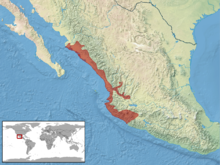Crotalus basiliscus
| Crotalus basiliscus | |
|---|---|

| |
| Scientific classification | |
| Domain: | Eukaryota |
| Kingdom: | Animalia |
| Phylum: | Chordata |
| Class: | Reptilia |
| Order: | Squamata |
| Suborder: | Serpentes |
| Family: | Viperidae |
| Genus: | Crotalus |
| Species: | C. basiliscus
|
| Binomial name | |
| Crotalus basiliscus (Cope, 1864)
| |

| |
| Synonyms[2] | |
Crotalus basiliscus, known as the Mexican west coast rattlesnake,[3] Mexican green rattler, and also by other names,[4] is a species of pit viper in the family Viperidae. The species is endemic to western Mexico. Like all other pit vipers, it is venomous. The specific name, basiliscus, is derived from the Greek word for king, βασιλισκος (basiliskos), and alludes to this snake's large size and potent venom.[3] No subspecies are currently recognized.[5]
Description

C. basiliscus is one of the largest rattlesnake species. Specimens exceeding 150 cm (4.9 ft) are not uncommon, while the maximum size reported is 204.5 cm (6.71 ft) (Klauber, 1972).[3] The body is moderately stout and rather rectangular in cross section.[6] Female rattlesnakes of the species are mature at a minimum length of 100 cm (3.3 ft) and a weight of 700 g (1.5 lb).[7]
At midbody, 25-29 rows of strongly keeled
The color pattern consists of brown or grayish ground color overlaid with 26-41 dark, rhombus-shaped (diamond) blotches with light edges. The head is a uniform grayish-brown except for its lighter
This
Common names
Common names for C. basiliscus include Mexican west coast rattlesnake,[3] Mexican green rattler,[4] Mexican west coast green rattlesnake,[8] and in Spanish cascabel verde mexicana.[4]
Geographic range
This rattler, C. basiliscus, is found in western Mexico from southern
Habitat
Around Colima, where C. basiliscus is (or was at one point) particularly plentiful, the area has been described as mostly treeless and covered with short grass with scattered clumps of mesquite, acacias, and other thorny bushes, as well as plenty of large cacti. The habitat of C. basiliscus is mostly tropical thorn forest, with an extension into tropical deciduous forest.[1]
Conservation status
The species C. basiliscus is classified as Least Concern on the IUCN Red List (v3.1, 2001).[1] Species are listed as such due to their wide distribution, presumed large population, or because they are unlikely to be declining fast enough to qualify for listing in a more threatened category. The trend for this species was stable when assessed in 2007.[9]
Behavior
In the lowlands, C. basiliscus is primarily active during the rainy summer months, and most specimens are found crossing the roads at night. However, a few have been seen basking early in the morning.[3] It has been reported to tame quickly in captivity.[4]
Feeding
Klauber reported that the stomachs of seven specimens of C. basiliscus contained mammal hair, probably belonging to rodents.[4]
Venom
Crotalus basilicus is known to produce large amounts of highly toxic venom, and large specimens should be regarded as very dangerous.[6]
Brown (1973) mentioned an average venom yield of 297 mg (dried venom), as well as LD50 values of 11.1 mg/kg IV and 4.0 and 12.9 mg/kg IP.[10]
In some populations, the venom may contain a component structurally related to
Taxonomy
Before 1989, two
References
- ^ . Retrieved 11 November 2021.
- ^ ISBN 1-893777-01-4(volume).
- ^ ISBN 0-8014-4141-2.
- ^ ISBN 0-520-21056-5.
- ^ "Crotalus basiliscus ". Integrated Taxonomic Information System. Retrieved 4 February 2007.
- ^ ISBN 0-486-26629-X.
- ^ Loc Barragán, Jesús & Carbajal Márquez, Rubén & Woolrich-Piña, Guillermo & Navarro-Orozco, Roy. (2016). Crotalus basiliscus. Arboreal habitat use/ Litter size.. Mesoamerican Herpetology. 3. 494-496.
- ISBN 0-8069-6460-X.
- ^ 2001 Categories & Criteria (version 3.1) at the IUCN Red List. Accessed 13 September 2007.
- ISBN 0-398-02808-7.
- ISBN 0-8014-4141-2.
- ^ Crotalus basiliscus at Munich AntiVenom INdex. Accessed 4 February 2007.
- ^ "Crotalus totonacus ". Integrated Taxonomic Information System. Retrieved 27 August 2007.
Further reading
- Cope ED (1864). "Contributions to the Herpetology of Tropical America". Proc. Acad. Nat. Sci. Philadelphia 16: 166-181. (Caudisona basilisca, new species, p. 166).
External links
- Crotalus basiliscus at the Reptarium.cz Reptile Database. Accessed 9 August 2007.
- Crotalus basiliscus at Biodiversity of Mexico. Accessed 4 February 2007.
- Longevity record for Crotalus basiliscus basiliscus at Max Planck Institute for Demographic Research. Accessed 4 February 2007.

